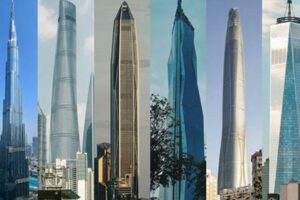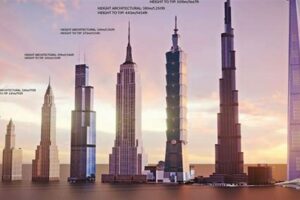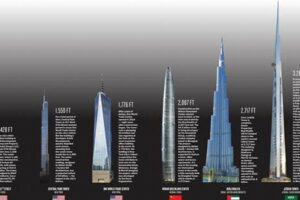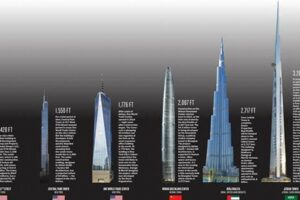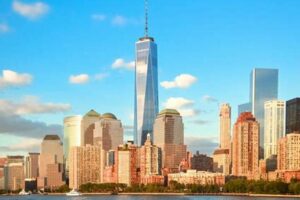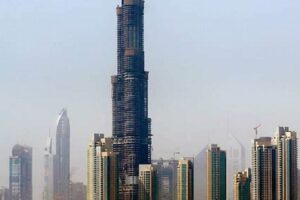The tallest skyscraper in Vietnam is the Landmark 81, which stands at 461 meters tall and has 81 floors. It is located in Ho Chi Minh City and was completed in 2018.
The Landmark 81 is a mixed-use development that includes residential, office, and retail space. It is also home to the Vincom Center, which is one of the largest shopping malls in Southeast Asia. The skyscraper is a major landmark in Ho Chi Minh City and offers stunning views of the city and the surrounding area.
The construction of the Landmark 81 was a major undertaking and required the use of innovative engineering techniques. The building is designed to withstand earthquakes and typhoons, which are common in Vietnam. The Landmark 81 is also equipped with a state-of-the-art fire safety system.
1. Landmark 81
Landmark 81, towering at 461 meters with 81 floors, is the tallest skyscraper in Vietnam. This architectural marvel is a key component of the Vinhomes Central Park complex, an ambitious urban development in Ho Chi Minh City. As the tallest building in the country, Landmark 81 has become an iconic landmark and a symbol of Vietnam’s economic growth and architectural prowess.
The connection between Landmark 81 and its status as the tallest skyscraper in Vietnam is significant for several reasons. Firstly, the building’s height is a testament to the country’s rapidly developing economy and its growing presence on the global stage. Landmark 81 represents Vietnam’s ambition to compete with other major cities in the region and beyond. Secondly, the building’s design and construction are a showcase of Vietnam’s engineering and architectural capabilities. The building incorporates advanced technologies to ensure safety and sustainability, making it a model for future high-rise developments in the country. Finally, Landmark 81 has had a significant impact on the urban landscape of Ho Chi Minh City. The building has attracted businesses, residents, and tourists, creating a vibrant and dynamic urban hub.
In conclusion, the connection between Landmark 81 and its status as the tallest skyscraper in Vietnam is a reflection of the country’s economic growth, architectural prowess, and ambition to become a major player on the global stage. The building is not only a symbol of Vietnam’s achievements but also a catalyst for further development and innovation in the country.
461 Meters Tall
The height of 461 meters is a defining feature of Landmark 81, the tallest skyscraper in Vietnam. This extraordinary elevation contributes significantly to the building’s iconic status and its recognition as a symbol of Vietnam’s economic and architectural achievements.
The height of 461 meters is not merely a numerical value but a testament to Vietnam’s ambition and its commitment to innovation. By constructing a skyscraper of such magnitude, Vietnam has demonstrated its ability to compete with other major cities in the region and beyond. Landmark 81 stands as a symbol of the country’s rapid economic growth and its aspirations to become a global player.
In addition to its symbolic significance, the height of 461 meters has practical implications for the building’s design and functionality. The elevation allows for panoramic views of Ho Chi Minh City and its surroundings, making it a popular destination for tourists and locals alike. The building’s height also provides ample space for a variety of uses, including residential, office, and retail.
Furthermore, the height of 461 meters poses engineering challenges that require innovative solutions. The building’s structural design incorporates advanced technologies to ensure stability and safety in the face of high winds and seismic activity. These engineering feats showcase Vietnam’s capabilities in the field of architecture and construction.
In conclusion, the height of 461 meters is a defining feature of Landmark 81, the tallest skyscraper in Vietnam. This extraordinary elevation symbolizes Vietnam’s economic growth, architectural prowess, and ambition to become a major player on the global stage. The building’s height presents engineering challenges that require innovative solutions, while also providing practical benefits and contributing to the building’s iconic status.
2. 81 Floors
In the context of Vietnam’s tallest skyscraper, the Landmark 81, the number of floors, which stands at 81, holds significant meaning. It is not merely a numerical value but an integral component that contributes to the building’s overall height, design, and functionality.
The 81 floors of Landmark 81 are a reflection of Vietnam’s ambition and its commitment to innovation. By constructing a skyscraper with such a large number of floors, Vietnam has demonstrated its ability to compete with other major cities in the region and beyond. Landmark 81 stands as a symbol of the country’s rapid economic growth and its aspirations to become a global player.
In addition to its symbolic significance, the 81 floors have practical implications for the building’s design and functionality. The large number of floors allows for a variety of uses, including residential, office, and retail. This mixed-use design creates a vibrant and dynamic urban environment, attracting businesses, residents, and tourists alike.
Furthermore, the 81 floors present engineering challenges that require innovative solutions. The building’s structural design incorporates advanced technologies to ensure stability and safety in the face of high winds and seismic activity. These engineering feats showcase Vietnam’s capabilities in the field of architecture and construction.
In conclusion, the 81 floors of Landmark 81, the tallest skyscraper in Vietnam, are not just a numerical value but a testament to Vietnam’s economic growth, architectural prowess, and ambition to become a major player on the global stage. The building’s 81 floors provide ample space for a variety of uses, present engineering challenges that require innovative solutions, and contribute to the building’s iconic status.
3. Mixed-use Development
The connection between “mixed-use development” and “tallest skyscraper in Vietnam” is significant as it contributes to the building’s overall functionality and urban impact. A mixed-use development is a building or that combines different types of uses, such as residential, office, retail, and hospitality, within the same structure. In the case of Landmark 81, the tallest skyscraper in Vietnam, the mixed-use design plays a crucial role in creating a vibrant and dynamic urban environment.
The integration of multiple uses within Landmark 81 offers several advantages. Firstly, it promotes walkability and reduces reliance on cars. Residents, workers, and visitors can conveniently access a range of amenities and services within the same building, fostering a sense of community and reducing traffic congestion. Secondly, mixed-use developments contribute to the economic vitality of an area by attracting businesses, creating employment opportunities, and stimulating local businesses. Landmark 81, with its retail and commercial spaces, has become a hub for businesses and a popular destination for shoppers and tourists.
Furthermore, the mixed-use design allows for more efficient use of space and resources. By combining different functions within a single building, it reduces the need for separate structures and minimizes land use. This approach is particularly important in densely populated urban areas like Ho Chi Minh City, where land is scarce and expensive. The vertical integration of different uses in Landmark 81 optimizes space utilization and creates a more sustainable urban environment.
In conclusion, the mixed-use development is an integral component of the tallest skyscraper in Vietnam, Landmark 81. It contributes to the building’s functionality, creates a vibrant urban environment, promotes economic vitality, and optimizes space utilization. The integration of multiple uses within a single skyscraper is a key factor in its success and sets an example for future high-rise developments in Vietnam and beyond.
4. Residential, office, retail
The combination of residential, office, and retail spaces within the tallest skyscraper in Vietnam, Landmark 81, is a strategic design decision that contributes to the building’s overall functionality and impact on the urban environment. This mixed-use development model offers several key benefits and plays a crucial role in shaping the building’s significance.
Firstly, the integration of residential units within Landmark 81 creates a vibrant and diverse community within the building itself. Residents enjoy the convenience of living in close proximity to their workplaces, retail outlets, and other amenities, fostering a sense of community and reducing the need for excessive commuting. This vertical integration promotes walkability and reduces traffic congestion, contributing to a more sustainable urban environment. The presence of office spaces within Landmark 81 attracts businesses and creates employment opportunities, contributing to the economic vitality of the area. The building’s central location and state-of-the-art facilities make it an attractive destination for businesses looking to establish a presence in Ho Chi Minh City. The mixed-use design allows for efficient use of space and resources, minimizing the need for separate office buildings and reducing the overall urban footprint.
The inclusion of retail spaces within Landmark 81 creates a dynamic and convenient shopping and entertainment destination for residents, workers, and visitors alike. The retail component contributes to the building’s overall appeal and attracts a wide range of businesses, from luxury brands to local retailers. This diversity enhances the building’s functionality and makes it a popular hub for both everyday shopping and special occasions.
In conclusion, the combination of residential, office, and retail spaces within the tallest skyscraper in Vietnam, Landmark 81, is a well-conceived design strategy that contributes to the building’s functionality, economic impact, and overall significance. This mixed-use development model creates a vibrant and sustainable urban environment, promotes walkability, and optimizes space utilization. The success of Landmark 81 serves as an example for future high-rise developments, demonstrating the benefits of integrating multiple uses within a single skyscraper.
5. Vincom Center
The connection between Vincom Center and the tallest skyscraper in Vietnam, Landmark 81, is significant as it establishes the building as a prominent retail and entertainment destination within the Ho Chi Minh City metropolitan area. Vincom Center, a renowned shopping mall chain in Vietnam, occupies a substantial portion of the lower floors within Landmark 81, offering a diverse range of retail options, dining experiences, and entertainment facilities.
The presence of Vincom Center within Landmark 81 enhances the building’s overall functionality and appeal. The mall serves as a convenient and accessible shopping destination for residents, workers, and visitors alike, catering to their various lifestyle needs. The integration of retail spaces within the skyscraper creates a dynamic and vibrant urban environment, attracting a wide range of local and international brands. This synergy between retail and residential/office components contributes to the building’s economic vitality and establishes it as a hub for commerce and leisure.
Furthermore, Vincom Center serves as a key attraction within Landmark 81, attracting a large number of visitors and contributing to the building’s overall popularity. The mall’s strategic location within the tallest skyscraper in Vietnam provides breathtaking views of the city, making it a popular destination for tourists and locals seeking a unique shopping and dining experience. This integration of retail and architectural grandeur enhances the building’s overall appeal and makes it a landmark destination within Ho Chi Minh City.
In conclusion, the connection between Vincom Center and the tallest skyscraper in Vietnam, Landmark 81, is mutually beneficial. Vincom Center establishes the building as a prominent retail and entertainment destination, while the skyscraper’s iconic status and architectural significance enhance the mall’s visibility and appeal. This strategic partnership contributes to the overall success and popularity of both entities, solidifying their position within the urban landscape of Ho Chi Minh City.
6. State-of-the-art design
The connection between “state-of-the-art design” and “tallest skyscraper in Vietnam” is significant, as the design of a skyscraper plays a crucial role in determining its overall functionality, efficiency, and impact on the urban environment. State-of-the-art design incorporates cutting-edge technologies, innovative materials, and sustainable practices to create skyscrapers that are not only visually stunning but also structurally sound, environmentally friendly, and responsive to the needs of modern-day living and working.
In the case of the tallest skyscraper in Vietnam, Landmark 81, its state-of-the-art design has been instrumental in its success and recognition. The building’s aerodynamic shape, inspired by the traditional Vietnamese Ao Dai dress, reduces wind resistance and enhances structural stability. Its high-performance glass facade maximizes natural light and offers panoramic views of the city, while also providing thermal insulation and energy efficiency. Landmark 81 also features advanced building management systems that optimize energy consumption, water usage, and indoor air quality.
The practical significance of understanding the connection between “state-of-the-art design” and “tallest skyscraper in Vietnam” lies in its implications for sustainable urban development. By incorporating sustainable design principles into high-rise buildings, architects and engineers can create structures that minimize their environmental footprint, promote occupant well-being, and contribute to the overall livability of cities. The success of Landmark 81 demonstrates the potential of state-of-the-art design to transform the built environment and set new standards for sustainable skyscraper development.
7. Earthquake and typhoon resistant
The connection between “earthquake and typhoon resistant” and “tallest skyscraper in Vietnam” is paramount, as it underscores the critical importance of structural integrity and resilience in high-rise buildings, especially in a region prone to natural disasters.
- Structural Reinforcement
To withstand the immense forces exerted by earthquakes and typhoons, the tallest skyscraper in Vietnam employs reinforced concrete and steel structures. These materials are exceptionally robust and can endure significant stress without compromising the building’s integrity.
- Wind-resistant Design
The building’s aerodynamic shape and strategically placed windbreaks minimize wind resistance and prevent excessive swaying during storms. This design ensures stability and reduces the risk of structural damage.
- Seismic Dampers
Advanced seismic dampers are installed throughout the skyscraper to absorb and dissipate seismic energy. These devices act as shock absorbers, reducing the impact of earthquakes on the building’s structure.
- Emergency Preparedness
The building is equipped with comprehensive emergency systems, including backup generators, water reservoirs, and evacuation plans. These measures ensure the safety and well-being of occupants during and after natural disasters.
These facets of earthquake and typhoon resistance collectively contribute to the resilience and safety of the tallest skyscraper in Vietnam. By incorporating these design elements, the building can withstand the forces of nature, providing a safe and secure environment for its occupants, even in the face of extreme weather events.
8. Fire Safety System
The connection between “fire safety system” and “tallest skyscraper in Vietnam” is critical, as it emphasizes the vital role of fire protection measures in ensuring the safety of occupants and the integrity of the building in the event of a fire.
The tallest skyscraper in Vietnam is equipped with a comprehensive fire safety system that incorporates the latest technologies and best practices. This system includes:
- Fire Sprinklers: A network of sprinklers is installed throughout the building, activated by heat to suppress and control fires.
- Fire Alarm System: A sophisticated alarm system detects smoke and heat, triggering an alert to evacuate the building and summon emergency responders.
- Fire Extinguishers: Portable fire extinguishers are strategically placed on each floor for quick response to small fires.
- Emergency Exits: Clearly marked and well-lit emergency exits provide safe evacuation routes for occupants.
- Firefighting Equipment: The building is equipped with advanced firefighting equipment, including hoses and pumps, to assist emergency responders in extinguishing fires.
The importance of a fire safety system in the tallest skyscraper in Vietnam cannot be overstated. High-rise buildings pose unique fire safety challenges due to their height and density of occupants. A comprehensive fire safety system helps to mitigate these challenges and protect lives and property.
In conclusion, the “fire safety system” is an indispensable component of the “tallest skyscraper in Vietnam,” ensuring the safety and well-being of occupants and the integrity of the building in the event of a fire. By incorporating advanced technologies and adhering to strict safety codes, the building provides a safe and secure environment for its occupants.
Frequently Asked Questions about the Tallest Skyscraper in Vietnam
This section addresses frequently asked questions about the tallest skyscraper in Vietnam, providing concise and informative answers to common concerns or misconceptions.
Question 1: What is the name of the tallest skyscraper in Vietnam?
Answer: Landmark 81
Question 2: How tall is Landmark 81?
Answer: 461 meters (1,513 feet)
Question 3: How many floors does Landmark 81 have?
Answer: 81 floors
Question 4: What is the primary use of Landmark 81?
Answer: Mixed-use development, including residential, office, retail, and hospitality
Question 5: When was Landmark 81 completed?
Answer: 2018
Question 6: What architectural features make Landmark 81 unique?
Answer: Aerodynamic shape inspired by the traditional Vietnamese Ao Dai dress, high-performance glass facade for energy efficiency and panoramic views
Tips for Visiting the Tallest Skyscraper in Vietnam
Visiting the tallest skyscraper in Vietnam, Landmark 81, can be an unforgettable experience. Here are some tips to help you make the most of your visit:
Tip 1: Book your tickets in advance. Landmark 81 is a popular tourist destination, so it’s a good idea to book your tickets online in advance to avoid long lines.
Tip 2: Arrive early. The observation deck is located on the 81st floor, and it can take some time to get to the top. Arrive early to give yourself plenty of time to enjoy the views.
Tip 3: Go on a clear day. The views from the observation deck are best on a clear day. If you’re visiting during the rainy season, be sure to check the weather forecast before you go.
Tip 4: Bring your camera. The observation deck offers panoramic views of Ho Chi Minh City, so be sure to bring your camera to capture the stunning scenery.
Tip 5: Allow plenty of time. There’s a lot to see and do at Landmark 81, so be sure to allow plenty of time for your visit. You can easily spend several hours exploring the observation deck, shopping in the mall, or dining in one of the restaurants.
Summary: By following these tips, you can make the most of your visit to the tallest skyscraper in Vietnam. Enjoy the breathtaking views, explore the mall, and dine in one of the many restaurants. Landmark 81 is a must-see for any visitor to Ho Chi Minh City.
Landmark 81
Landmark 81, the tallest skyscraper in Vietnam, stands as a testament to the country’s rapid economic growth and architectural prowess. Its 81 floors and mixed-use design, incorporating residential, office, retail, and hospitality spaces, create a vibrant and dynamic urban environment. The building’s state-of-the-art design incorporates advanced technologies to ensure safety and sustainability, while its earthquake and typhoon resistance measures demonstrate Vietnam’s commitment to disaster preparedness.
The observation deck on the 81st floor offers breathtaking panoramic views of Ho Chi Minh City, making it a popular destination for tourists and locals alike. The building also houses the Vincom Center, one of the largest shopping malls in Southeast Asia, further enhancing its appeal as a commercial and entertainment hub. Landmark 81 serves as a symbol of Vietnam’s growing economic power and its ambition to become a major player on the global stage.


